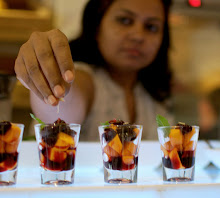Sagpaita is a name given to all lentils cooked with winter greens. Spinach, Chenopodium (bathua), Fenugreek greens (methi), Chane ka saag (chickpea greens) or a mix of spinach and dill leaves, fenugreek greens and dill leaves etc is cooked with any lentil to make a saucy daal rich with flavours of garlic, hing and cumin used for the tadka.
Sagpaita is basically a winter food that is considered warming and hydrating for the body at the same time. The lentils used mostly for sagpaita are arhar ki daal (split pigeon peas), chane ki daal (split chickpeas) or urad daal (split black beans) but a mix of lentils is also used. Mung ki daal (split mung beans) is also cooked to make sagpaita but it is mostly with baby spinach or baby fenugreek greens.
All these sagpaita recipes are slightly different from each other despite being a mix of lentils and greens basically but the taste of each sagpaita tells you how and why each one is cooked differently.
We do cook lentils with purslane greens in summers too but somehow sagpaita is a name given to the ones cooked with winter greens only. No wonder, the daal can include a lot of spices and loads of ghee is topped over the bowls of sagpaita. It has to be a winter delicacy as the recipe is tuned to be eaten in winters. All parts of Uttar Pradesh get very chilly during the 2 months of winter and there are various foods made with fresh produce to stay warm.
This chane ki daal ka sagpaita with bathue ka saag is made differently in each family. Some would add a little urad dal to it and some would add some fresh green peas or 'harey chane' but the tempering will always have some hing-jeera-lasun and laal mirch along with mild spices like dhaniya, jeera, kali mirch powder and may be a couple of tejpatta. There is good protein in the daal along with a lot of greens, so the hing and garlic etc is added to allow proper digestion of the sagpaita.
I sometimes add es of paneer to my sagpaita to make it a one pot meal. Otherwise it is best enjoyed with plain boiled rice, some bhujia type dry subzi, raita and papad kind of Indian meals.
ingredients
(2-3 large servings)
For pressure cooking
chane ki daal (split chickpeas 100 gm (scant half cup)
finely chopped bathua (chenopodium greens) 300 gm (2 cups packed)
minced ginger 1 tbsp
salt to taste
turmeric powder 1 tsp
water 1.5 cup
For tempering
ghee 1 tbsp
cumin seeds 1 tsp
hing (asafotida) a pinch
chopped garlic 1-2 tsp according to taste
red chilly powder 1/2 tsp or more to taste
everyday curry powder 1 tsp (optional)
lime juice to serve.
Paneer cubes as per requirement.
procedure
Pressure cook the daal and bathua greens along with the ingredients listed. Wait till the pressure builds up and the whistle blows, then cook on low flame for 10 minutes.
Prepare the tempering by heating the ghee and then adding the ingredients one after the other in the order listed. Make sure the garlic gets pink in colour and turns aromatic before you add the chilly powder and then remove the pan from the stove and pour the ingredients into the cooked daal. Mix well and churn the daal mixture if you like the sagpaita a bit saucy.
Serve hot with some lime juice or hot melted ghee or butter on top. This can be served with all the usual Indian accompaniments for a meal as I mentioned.
When I add paneer cubes I usually let the sagpaita simmer for a few minutes to soften the paneer before serving. Sagpaita or bathue wali chane ki daal has a distinct aroma of hing, cumin seeds and garlic that we call 'hing-jeera-lehsun ka tadka' and a mild kick imparted by red chillies. The base is earthy with bathua and chana dal that makes this sagpaita a very uniquely flavoured daal.
You can cook this daal with arhar (toor or pigeon peas) ki daal as well. The recipe wont changeeven if you use a mix of chane and arhar ki daal. But mung and urad daals need a different treatment. We will talk about that when I share the recipe of sagpaita with those lentils.
Enjoy bathua chane ki daal ka saigpaita till then.
















that looks yummy :) and one of my favourites tooooo
ReplyDeleteBikram's
That looks yummy. Would be wonderful to have with chapatis. :D
ReplyDeleteKya yaad dilaya aapne :). Back home it is commonly made with matar ki daal or chane ki daal and palak. In chhonk, use of mustard oil instead of ghee enhances the flavour, I was recently told. I don't make sagpita or sapaita (as it is colloquially known), but I do make dal with palak quite often, and have started using mustard oil since then. Never had it with bathua, will the process of spinach be the same?
ReplyDeleteThank you Puja. I have never tried with mustard oil ka tadka but will try next time. The process will be the same with all greens and lentils, the cooking time will differ and you might like to adjust the seasoning too. At our place sagpaita was a name for all saag and daal combinations although only dadi used to call these sagpaita. All of us used to call it palak wali daal or bathue wali daal and so on.
DeleteTrue, sagpita/ sapaita (cud have been sagpaita but sounded like sapaita) is the name for dal with saag combination. Frankly speaking, I was not too fond of sagpaita back home, but started making palak dal/ methi dal with tomatoes after I moved to Bangalore. I found it to be the easiest way of including greens in the food. Will try the good old sagpaita too once.
Delete